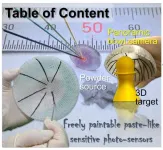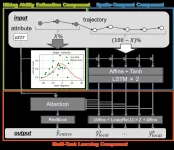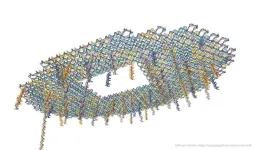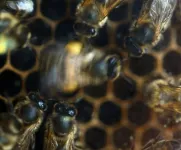(Press-News.org) The first life on Earth formed four billion years ago, as microbes living in pools and seas: what if the same thing happened on Mars? If it did, how would we prove it? Scientists hoping to identify fossil evidence of ancient Martian microbial life have now found a way to test their hypothesis, proving they can detect the fossils of microbes in gypsum samples that are a close analogy to sulfate rocks on Mars.
“Our findings provide a methodological framework for detecting biosignatures in Martian sulfate minerals, potentially guiding future Mars exploration missions,” said Youcef Sellam, PhD student at the Physics Institute, University of Bern, and first author of the article in Frontiers in Astronomy and Space Sciences. “Our laser ablation ionization mass spectrometer, a spaceflight-prototype instrument, can effectively detect biosignatures in sulfate minerals. This technology could be integrated into future Mars rovers or landers for in-situ analysis.”
Water, water everywhere
Billions of years ago, the water on Mars dried up. Gypsum and other sulfates formed when pools evaporated, leaving behind minerals that precipitated out of the water – and potentially fossilizing any organic life left behind. This means that if microbes such as bacteria lived there, traces of their presence could be preserved as fossils.
“Gypsum has been widely detected on the Martian surface and is known for its exceptional fossilization potential,” explained Sellam. “It forms rapidly, trapping microorganisms before decomposition occurs, and preserves biological structures and chemical biosignatures.”
But to identify these microbial fossils we first need to prove we can identify similar fossils in places where we know such microbes existed — such as Mediterranean gypsum formations that developed during the Messinian Salinity Crisis.
“The Messinian Salinity Crisis occurred when the Mediterranean Sea was cut off from the Atlantic Ocean,” said Sellam. “This led to rapid evaporation, causing the sea to become hypersaline and depositing thick layers of evaporites, including gypsum. These deposits provide an excellent terrestrial analog for Martian sulfate deposits.”
The scientists selected an instrument that could be used on a spaceflight: a miniature laser-powered mass spectrometer, which can analyze the chemical composition of a sample in detail as fine as a micrometer. They sampled gypsum from Sidi Boutbal quarry, Algeria, and analyzed it using the mass spectrometer and an optical microscope, guided by criteria which can help distinguish between potential microbial fossils and natural rock formations. These include morphology which is irregular, sinuous, and potentially hollow, as well as the presence of chemical elements necessary for life, carbonaceous material, and minerals like clay or dolomite which can be influenced by the presence of bacteria.
Life on Mars?
The scientists identified long, twisting fossil filaments within the Algerian gypsum, which have previously been interpreted as benthic algae or cyanobacteria, and are now thought to be sulfur-oxidizing bacteria like Beggiatoa. These were embedded in gypsum, and surrounded by dolomite, clay minerals, and pyrite. The presence of these minerals signals the presence of organic life, because prokaryotes — cells without a nucleus — supply elements which clay needs to form. They also facilitate dolomite formation in an acidic environment like Mars by increasing the alkalinity around them and concentrating ions in their cell envelopes. For dolomite to form within gypsum without the presence of organic life, high temperatures and pressures would be needed that would have dehydrated the gypsum, and which aren’t consistent with our knowledge of the Martian environment.
If mass spectrometers identify the presence of clay and dolomite in Martian gypsum in addition to other biosignatures, this could be a key signal of fossilized life, which could be reinforced by analyzing other chemical minerals present and by looking for similar organically formed filaments.
“While our findings strongly support the biogenicity of the fossil filament in gypsum, distinguishing true biosignatures from abiotic mineral formations remains a challenge,” cautioned Sellam. “An additional independent detection method would improve the confidence in life detection. Additionally, Mars has unique environmental conditions, which could affect biosignature preservation over geological periods. Further studies are needed.”
“This research is the first astrobiology study to involve Algeria and the first to use an Algerian terrestrial analog for Mars,” said Sellam. “As an Algerian researcher, I am incredibly proud to have introduced my country to the field of planetary science.
“This work is also dedicated to the memory of my father, who was a great source of strength and encouragement. Losing him during this research was one of the most difficult moments of my life. I hope that he is proud of what I have achieved.”
END
Laser-powered device tested on Earth could help us detect microbial fossils on Mars
Scientists successfully identify microbe fossils in terrestrial rocks like those found on Mars, opening up the possibility of searching for fossils on the Red Planet
2025-02-25
ELSE PRESS RELEASES FROM THIS DATE:
Non-destructive image sensor goes beyond bulkiness
2025-02-25
While photo-thermoelectric (PTE) sensors are potentially suitable for testing applications, such as non-destructive material-identification in ultrabroad millimeter-wave (MMW)–infrared (IR) bands, their device designs have primarily employed a single material as the channel. In general, PTE sensors combine photo-induced heating with associated thermoelectric (TE) conversion, and the employment of a single material channel regulates the utilization of devices by missing the opportunity for fully utilizing their fundamental parameters. ...
1st Japanese version of US psychological scale for esophageal symptoms
2025-02-25
Psychological factors have a greater impact on the severity of symptoms in esophageal diseases than objective evaluations, such as acid reflux and esophageal motility function. Although there are questionnaires that assess general psychological states in Japan, there were none that were specific to esophageal symptoms. In the United States, meanwhile, the Esophageal Hypervigilance and Anxiety Scale (EHAS) questionnaire that evaluates symptom-specific hypervigilance and anxiety for esophageal symptoms was developed in 2018.
In an effort to expand the use of EHAS, Dr. Akinari Sawada’s research group at Osaka Metropolitan ...
HikingTTE: a deep learning approach for hiking travel time estimation based on personal walking ability
2025-02-25
At the University of Electro-Communications, a research team led by Mizuho Asako, Yasuyuki Tahara, Akihiko Ohsuga, and Yuichi Sei has developed a new deep learning model called "HikingTTE" that significantly improves hiking travel time estimation. Hiking is popular worldwide, but accidents still occur when hikers underestimate the time needed to reach their destination.
This model could help reduce mountain accidents and improve hiker safety by providing more accurate travel time predictions. Previous hiking travel time estimation methods often use the relationship between slope (uphill or downhill) and walking speed. However, these ...
Environment nudges birds to fast, or slow, life lane
2025-02-25
Birds worldwide make strategic decisions about how they live based on their environmental conditions. Some live fast, die young, and leave as many chicks as possible. Others live long and prosper by not breeding.
A new study of non-migratory birds provides clues about how climate change may affect the long-standing evolutionary strategies of feathered friends. The work is reported in this week’s Ecology Letters and was led by Michigan State University postdoctoral fellows of the MSU Institute for Biodiversity, Ecology, Evolution, and Macrosystems (IBEEM).
The ...
The U-shaped relationship between admission peripheral oxygen saturation and all-cause hospital mortality in acute exacerbation of chronic obstructive pulmonary disease: a retrospective analysis using
2025-02-25
Highlight box
Key findings
• This study investigated the U-shaped nonlinear relationship between admission oxygen saturation (SpO2) and all-cause hospital mortality in patients with acute exacerbation of chronic obstructive pulmonary disease (AECOPD). The results showed that the lowest all-cause hospital mortality was observed at an SpO2 of 89.5%. Additionally, SpO2 was identified as an independent risk factor for predicting all-cause hospital mortality in AECOPD patients, providing valuable guidance for optimizing oxygen therapy in this population.
What is known and what is new?
• Most studies indicate that maintaining SpO2 levels between 88–92% provides ...
New research highlights wide variation in prostate cancer testing between GP practices
2025-02-25
A largescale study has found huge variation between GP practices on whether they are likely to pick up prostate cancer using a blood test.
The University of Exeter led a study which aimed to investigate the proportion of patients whose prostate cancer was identified by using a prostate-specific antigen (PSA) test when patients had no symptoms.
The research published in the British Journal of General Practice and funded by Cancer Research UK, and, has found that one in five patients with prostate cancer in England are diagnosed after PSA testing when they had no symptoms – fewer than previously thought. The PSA test ...
Antidepressants linked to faster cognitive decline in dementia
2025-02-25
New research suggests that antidepressants can accelerate cognitive decline in people with dementia. At the same time, some drugs appear to be less harmful than others, which can help doctors make better treatment decisions, according to the study published in BMC Medicine.
Antidepressants are often used to relieve symptoms such as anxiety, depression, aggressiveness, and sleep disturbances in dementia sufferers.
However, a new observational study based on data from the Swedish Dementia Registry (SveDem) shows that patients with dementia who are treated with antidepressants experience an increased cognitive decline compared to patients who do not ...
DNA origami suggests route to reusable, multifunctional biosensors
2025-02-25
Using an approach called DNA origami, scientists at Caltech have developed a technique that could lead to cheaper, reusable biomarker sensors for quickly detecting proteins in bodily fluids, eliminating the need to send samples out to lab centers for testing.
"Our work provides a proof-of-concept showing a path to a single-step method that could be used to identify and measure nucleic acids and proteins," says Paul Rothemund (BS '94), a visiting associate at Caltech in computing and mathematical sciences, and computation and neural systems.
A paper describing the work recently appeared in the journal Proceedings of the National Academy of Sciences. The lead authors of ...
Virginia Tech study reveals that honeybee dance ‘styles’ sway food foraging success
2025-02-25
As far as animals go, honeybees are world-class dancers.
While not as deep and complex as a Super Bowl half-time show, the bees' moves, known as the “waggle" dance, convey very specific food foraging instructions to their nestmates. The direction the dancer moves explains to other bees which way to go, and the duration of the waggle dance, or the “run,” shows how far to go. Once other bees have been convinced to follow the directions, they are “recruited.” After receiving the instructions, these ...
Beehive sensors offer hope in saving honeybee colonies
2025-02-25
A UC Riverside computer science team has developed a sensor-based technology that could revolutionize commercial beekeeping by reducing colony losses and lowering labor costs.
Called the Electronic Bee-Veterinarian, or EBV, the technology uses low-cost heat sensors and forecasting models to predict when hive temperatures may reach dangerous levels. The system provides remote beekeepers with early warnings, allowing them to take preventive action before their colonies collapse during extreme hot or cold weather or when the bees cannot regulate their hive temperature because of disease, pesticide exposure, food shortages, or other stressors. ...
LAST 30 PRESS RELEASES:
Exploring how the visual system recovers following injury
Support for parents with infants at pediatric check-ups leads to better reading and math skills in elementary school
Kids’ behavioral health is a growing share of family health costs
Day & night: Cancer disrupts the brain’s natural rhythm
COVID-19 vaccination significantly reduces risk to pregnant women and baby
The role of vaccination in maternal and perinatal outcomes associated with COVID-19 in pregnancy
Mayo Clinic smartwatch system helps parents shorten and defuse children's severe tantrums early
Behavioral health spending spikes to 40% of all children’s health expenditures, nearly doubling in a decade
Digital cognitive behavioral treatment for generalized anxiety disorder
Expenditures for pediatric behavioral health care over time and estimated family financial burden
Air conditioning in nursing homes and mortality during extreme heat
The Alps to lose a record number of glaciers in the next decade
What makes a good proton conductor?
New science reporting guide published for journalists in Bulgaria
New international study reveals major survival gaps among children with cancer
New science reporting guide published for journalists in Turkey
Scientists develop a smarter mRNA therapy that knows which cells to target
Neuroanatomy-informed brain–machine hybrid intelligence for robust acoustic target detection
Eight SwRI hydrogen projects funded by ENERGYWERX
The Lundquist Institute and its start-up company Vitalex Biosciences Announces Strategic Advancement of Second-Generation fungal Vaccine VXV-01 through Phase 1 Trials under $40 Million Competitive Con
Fine particles in pollution are associated with early signs of autoimmune disease
Review article | Towards a Global Ground-Based Earth Observatory (GGBEO): Leveraging existing systems and networks
Penn and UMich create world’s smallest programmable, autonomous robots
Cleveland researchers launch first major study to address ‘hidden performance killer’ in athletes
To connect across politics, try saying what you oppose
Modulating key interaction prevents virus from entering cells
Project explores barriers to NHS career progression facing international medical graduates
Jeonbuk National University researchers explore the impact of different seasonings on the flavor perception of Doenjang soup
Two Keck Medicine of USC Hospitals named Leapfrog Top Teaching Hospitals
World-first discovery uncovers how glioblastoma tumours dodge chemotherapy, potentially opening the door to new treatments
[Press-News.org] Laser-powered device tested on Earth could help us detect microbial fossils on MarsScientists successfully identify microbe fossils in terrestrial rocks like those found on Mars, opening up the possibility of searching for fossils on the Red Planet





